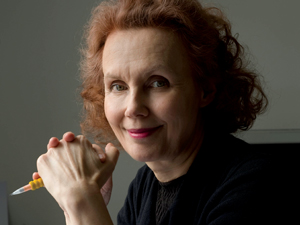 Kaija Saariaho paid Toronto a visit.
Kaija Saariaho paid Toronto a visit. Finnish cellist Anssi Karttunen was on hand to play Saariaho’s Sept papillons, an unaccompanied suite of cello pieces that the composer wrote for him. His performance was impressive – he clearly knows Sept papillons like the back of his hand, and was entirely equal to the work’s daunting technical demands.
Those demands included delicate tremolos, eerie harmonics, slithery glissandos, multiple stops and various scrunchy noises that defy categorization. Throughout the movements, successive gestures gradually blended into one another in an atonal stream of consciousness. While there were a few fleeting phrases that might have (but didn’t) blossom into a melody, Sept papillons is essentially a study in texture and timbre. In many ways, it was like an electroacoustic piece orchestrated.
Electronics were an overt presence in the next Saariaho piece. Frises is a set of four pieces for violin with live electroacoustic manipulation. The violinist for the occasion was Jennifer Koh, known for the intensity of her performances. As she played, Saariaho and her husband, Jean-Baptiste Barrière, were no less intensely modifying the violin’s sound from a control panel at the rear of the hall.
In style and technique, the violin part of Frises is much like Sept papillons. But the added electronics created an aura of resonance around the soloist. Koh effectively played up the contrasting aspects of the pieces, which were alternately ethereal and edgily dramatic.
Koh and Karttunen formed a well-matched duo for the world premiere of Aure, and they played with expression and even passion. Here, Saariaho has included some surprisingly Gershwin-esque phrases – however, these phrases soon wander off into distant realms of shimmering tremolos and glassy harmonics.
Pianist Ieva Jokubaviciute joined the two string players for Light and Matter. The piece opens with dark ruminations in the cello and piano that morph into more ruminations when the violin joins in. As the piece unfolded, I jotted down words to describe it: organic, fluid, fragile, fleeting, rarefied, ephemeral.
These adjectives sum up my reaction to pretty much everything I’ve heard by Saariaho. They are words that speak to the skill and sensitivity of her craft, but that also underscore the problematic aspects of her art – its inscrutability, instability and intangibility.
In conclusion, I can only say that I don’t exactly like her music – but there are things about it that I do like very much. And that is just plain frustrating.
There were two other works on the program. Daniel’s song-cycle You are where you are, for voice and piano quintet was performed by bass Robert Pomakov and members of the Royal Conservatory’s ARC Ensemble (violinists Erica Raum and Emily Kruspe, violist Steven Dann and cellist David Hetherington). The texts, by Yann Martel, present the First-World problems of a hapless man, such as deciding where to go on vacation or what to buy at the supermarket.
The music, stylistically located somewhere on a Bartók-Lutoslawski continuum, was clever and dramatic. But I’m not sure whether Pomakov’s stentorian delivery was deliberately intended for theatrical effect, or simply a display of over-singing.
Fitelberg was represented by his String Quartet No. 2. Its movements are alternately gnarly, jazzy, sentimental – with snippets of Bach-like counterpoint and ironic “wrong” notes. The ARC ensemble’s quartet gave a full-bodied performance, with confidence and authority.
© Colin Eatock 2015
 RSS Feed
RSS Feed

